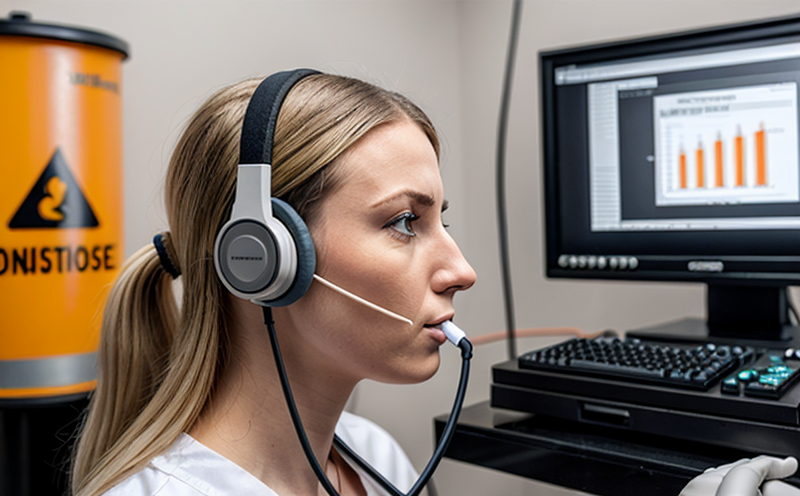EN 352-2 Earplug Performance Testing
The European Standard EN 352-2 specifies performance requirements and test methods for earplugs designed to protect against occupational noise exposure. This standard is crucial for ensuring that hearing protection devices (HPDs) meet the necessary safety and comfort standards required in various industries, including manufacturing, construction, and mining.
The testing method outlined in EN 352-2 evaluates several critical parameters of earplugs, such as attenuation levels, insertion loss, and sound quality. These tests are designed to simulate real-world usage conditions to ensure that the earplugs provide adequate protection against noise exposure while maintaining comfort for extended use.
Attenuation refers to the reduction in sound intensity due to the presence of the earplug. Insertion loss is a key parameter that measures how much sound is blocked when an earplug is properly inserted into the user's ear canal. Sound quality, on the other hand, ensures that while protecting against noise, the earplugs do not significantly impair communication or create discomfort.
The testing procedure involves fitting the earplug to a standardized test fixture designed to mimic the shape of the human ear canal. The fixture is then placed into an anechoic chamber where sound waves are introduced at various frequencies and levels. The performance of the earplug is measured by recording the amount of attenuation achieved under these conditions.
The methodology outlined in EN 352-2 ensures that the testing process is rigorous and repeatable, allowing manufacturers to demonstrate compliance with the standard. Compliance with this standard is important for both manufacturing standards and regulatory requirements, ensuring that products meet safety and comfort expectations.
Manufacturers can use these test results to optimize their product design, ensuring that they provide the necessary protection while remaining comfortable and effective over extended periods of use. This standard is particularly relevant in industries where workers are exposed to high noise levels, such as construction sites or manufacturing plants.
Real-world applications of EN 352-2 testing include regular quality control checks during production processes, ensuring that each batch of earplugs meets the required performance standards. Additionally, this standard is used for validating new product designs and for compliance with occupational health and safety regulations in various countries across Europe.
Scope and Methodology
The scope of EN 352-2 testing covers the evaluation of earplugs designed to protect against noise exposure, ensuring that they meet the specified performance criteria. The methodology involves several key steps:
- Fitting the earplug into a standardized test fixture.
- Placing the fixture in an anechoic chamber for sound wave testing.
- Recording and analyzing attenuation levels at various frequencies and intensities.
- Evaluating insertion loss under standard conditions.
- Assessing sound quality to ensure it does not impair communication or cause discomfort.
The test fixture used in EN 352-2 is designed to accurately simulate the shape of the human ear canal, ensuring that the results are representative of real-world use. The anechoic chamber provides a controlled environment for precise sound wave measurement, while data analysis tools ensure accurate and repeatable results.
The testing process is designed to be rigorous and standardized, allowing manufacturers to demonstrate compliance with EN 352-2. This ensures that the earplugs meet the necessary performance standards for noise protection and comfort. Compliance with this standard is important for both manufacturing quality control and regulatory requirements in various industries.
Benefits
- Compliance Assurance: Ensures that earplugs meet the stringent performance criteria outlined in EN 352-2, facilitating compliance with international standards and regulations.
- Quality Control: Regular testing helps manufacturers maintain consistent product quality by identifying any deviations from standard specifications early in the production process.
- User Comfort: Testing ensures that earplugs provide adequate noise protection without causing discomfort or impairing communication, enhancing user satisfaction and compliance with occupational health and safety regulations.
- Product Optimization: Real-world testing data helps manufacturers refine their product designs to improve performance and comfort, leading to more effective hearing protection solutions.
- Regulatory Compliance: Ensures that earplugs meet the necessary performance standards required by various countries across Europe, facilitating easier market access for manufacturers.
The benefits of EN 352-2 testing extend beyond compliance and quality control. By ensuring that earplugs provide adequate noise protection without causing discomfort or impairing communication, this standard enhances user satisfaction and compliance with occupational health and safety regulations. Real-world testing data also helps manufacturers refine their product designs to improve performance and comfort, leading to more effective hearing protection solutions.
Eurolab Advantages
EuroLab offers comprehensive EN 352-2 earplug performance testing services tailored to meet the specific needs of manufacturers and regulatory bodies. Our team of experts has extensive experience in noise protection testing, ensuring that our clients receive accurate and reliable test results.
Our state-of-the-art facilities include anechoic chambers equipped with advanced measurement tools, allowing us to provide precise and repeatable test results. We also offer flexible testing schedules to accommodate the busy demands of manufacturers and regulatory bodies.
In addition to EN 352-2 testing, EuroLab provides a wide range of other services related to occupational health and safety, including noise exposure assessments and hearing conservation program development. Our comprehensive approach ensures that clients receive the full spectrum of support they need to meet their compliance and quality control goals.





